Guitar Harmonics
Intro: Achieving the control and understanding of guitar harmonics is the way to increase the range of the instrument, playing notes that go beyond the fretboard. It is also a way to include some singular effects in your phrasing or riffs, bringing expression and individuality.
In this lesson we are going to understand what harmonics are, get to know the different types and their location on the fretboard of the guitar, and how to play them.
What is sound? When an object vibrates it pushes the air molecules around. This energy goes from one molecule to another like a wave. This form of propagation of energy using an elastic environment (solid, liquid or gas) we call sound. When it reaches our ear it vibrates accordingly and this kind of manifestation is interpreted by our brain as hearing.
Sound frequency is the velocity per second, measured in Hertz (Hz), of the vibration of an object. If an object vibrates 20 times in 1 second, its frequency is 20Hz. If it vibrates 500 times in 1 second, its frequency is 500Hz. Our ear in perfect acoustical conditions can hear from 20 up to 20,000 vibrations per second, which means from 20Hz (low note) up to 20KHz (high note). Below this it is called ‘infrasound’, and above ‘ultrasound’.
The A note that we use in music as a reference to tune our instrument vibrates 440 times in 1 second (440Hz). Every time this frequency doubles or is divided in half the octave shifts up or down, like this:
A 440Hz → doubling the velocity → A 880Hz (1 octave higher)
A 440Hz → dividing the velocity → A 220Hz (1 octave lower)
The frequency of each string on the guitar:
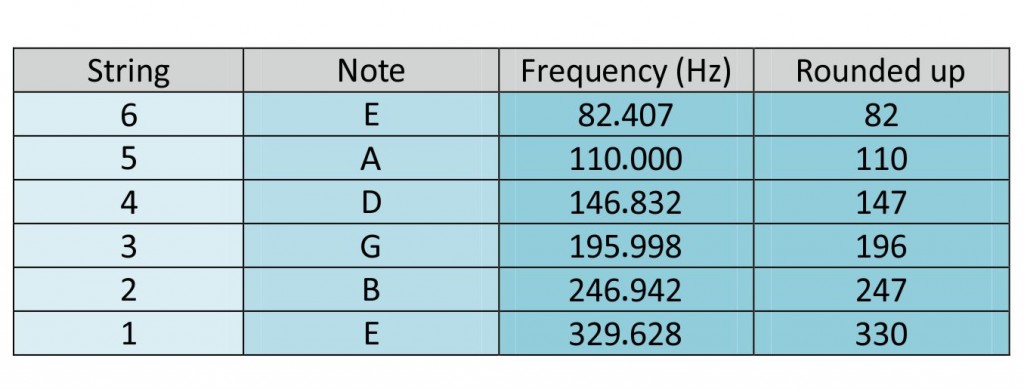
Using the fifth string to exemplify we have the following situations:
- When we play the open 5th string the note is A 110Hz.
- When we press our finger on the 12th fret we are dividing the string in half and the frequency doubles its speed, A 220Hz, one octave higher than the open string.
- When we press our finger on the 24th fret we are dividing the string in quarters and the frequency doubles again, A 440Hz, two octaves higher than the open string.
- When we press any other fret we are changing the length of the string and thus the velocity of the vibration, changing the note.
Sound amplitude is the quantity of energy (pressure) per time unit, so the higher the amplitude the higher the sound intensity (measured in decibels). The sound doubles its intensity every 6 decibels, so 18db is four times higher then 6db, not three. Sounds above 85db can, if we are exposed for long periods of time, damage our hearing. Around 130db is our pain limit and above that the damage is irreversible.
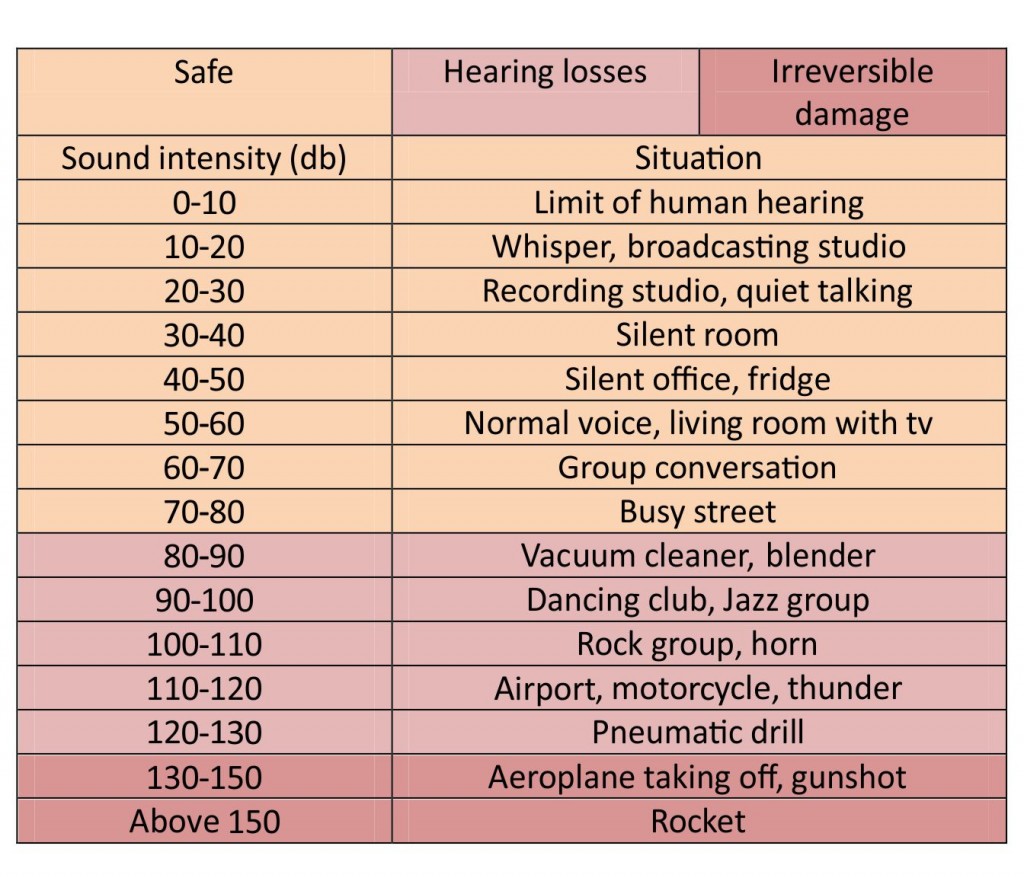
Harmonic Series: When a string vibrates it vibrates along its whole extension (Fig. 1), producing sound. At the same time this string vibrates in 2 parts (Fig. 2) producing a different sound with double the frequency of the open string, 1 octave higher. The string also vibrates in 3, 4, 5, 6 (Fig. 3-6) up to infinite parts, and each one of these vibrations produces a different sound with a different frequency that is higher than the previous one. All of these notes (including the first) are called harmonics. See the figure below:
When observing a string vibrating, it is quite difficult to recognize all the different vibrations and tell them apart because they get confused inside a visual mass, as shown in the figure below:
The harmonic sequence created by the vibration of a string in different parts, for each one of the guitar strings, can be visualised in the table below:
H → Harmonics from 1 to 16 (human limit)
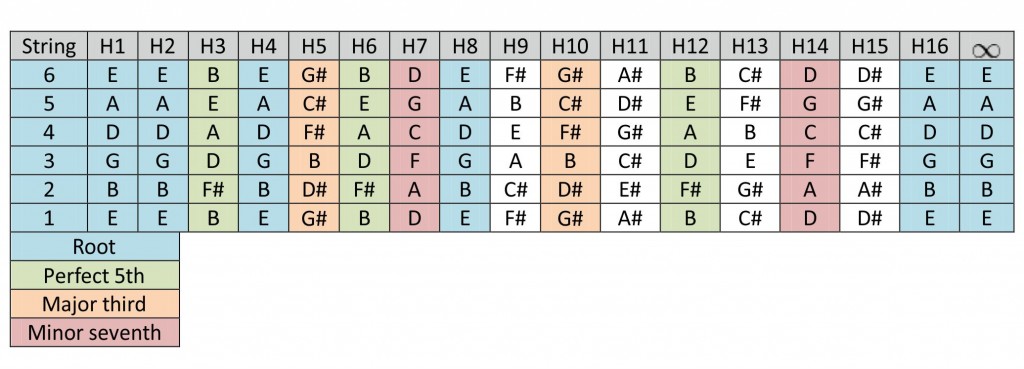
Visualizing and hearing the harmonics: It is possible to observe and hear each one of the different vibrations of a string using the resource of the natural harmonic recourse. Do the following…
1 – Play an open string and watch it vibrating along its whole extension. Near to the points where the string is attached to the guitar (bridge and nut) it is very difficult to notice the vibration, but it is very easy to spot it in the middle of the string where the amplitude reaches its maximum, as shown in the figure above (Fig. 1). The note we hear is the fundamental, also called the First Harmonic.
2 – Touch the finger of your left hand above the 12th fret without pressing, but just feeling the string, and then pluck it with your right hand. It is really hard to see any vibration at the 12th fret, but you can see the string vibrating in 2 parts (Fig. 2). The sound created is one octave higher than that of the open string, and it is called the Second Harmonic.
3 – Touch the finger of your left hand above the 7th fret without pressing the note, but just feeling the string, and then pluck it with your right hand. It is really hard to see any vibration at the 7th fret, but you can see the string vibrating in 3 parts (Fig. 3). The sound created is one octave plus a perfect fifth higher than the open string, and it is called the Third Harmonic.
4 – Touch the finger of your left hand above the 5th fret without pressing the note, but just feeling the string, and then pluck it with your right hand. It is really hard to see any vibration at the 5th fret, but you can see the string vibrating in 4 parts (Fig. 4). The sound created is two octaves higher than the open string, and it is called the Fourth Harmonic.
5 – Touch the finger of your left hand above the 4th fret (3.9) without pressing the note, but just feeling the string, and then pluck it with your right hand. It is really hard to see any vibration at the 4th fret, but you can see the string vibrating in 5 parts (Fig. 5). The sound created is two octaves plus a major third higher than the open string, and it is called the Fifth Harmonic.
You can continue to repeat this same process, dividing the string into 6, 7, 8, 9, …etc. parts, obtaining sounds each time higher than the previous one with the volume each time lower. Just keep plucking the string and moving your finger from the frets towards the nut of the guitar. The harmonics from the second and first frets are very hard to hear because they are very high in pitch.
Positions of the harmonics on the guitar:
As we always get the same note when dividing or multiplying the string by a factor of two, we have the equivalency of the note at different positions on the guitar…
1, ½, ¼, 1/8, 3/8, 5/8, ¾, 1/16 → Tonic
1/3, 2/3, 1/6, 5/6 → Perfect fifth
1/5, 2/5, 3/5, 4/5, 1/10, 3/10, 7/10, 9/10 → Major third
1/7, 2/7, 3/7, 4/7, 5/7, 6/7 → Minor seventh
1/9, 2/9, 4/9, 5/9, 7/9, 8/9 → Major second
Click on the image to enlarge
Click on the image to enlarge
Audio examples: The first seven harmonics after the fundamental note played on each string.
Audio clip: Adobe Flash Player (version 9 or above) is required to play this audio clip. Download the latest version here. You also need to have JavaScript enabled in your browser.
6th string – E B E G# B D E (form the E7 arpeggio).
5th string – A E A C# E G A (form the A7 arpeggio).
4th string – D A D F# A C D (form the D7 arpeggio).
3th string – G D G B D F G (form the G7 arpeggio).
2th string – B F# B D# F# A B (form the B7 arpeggio).
1th string – E B E G# B D E (form the E7 arpeggio).
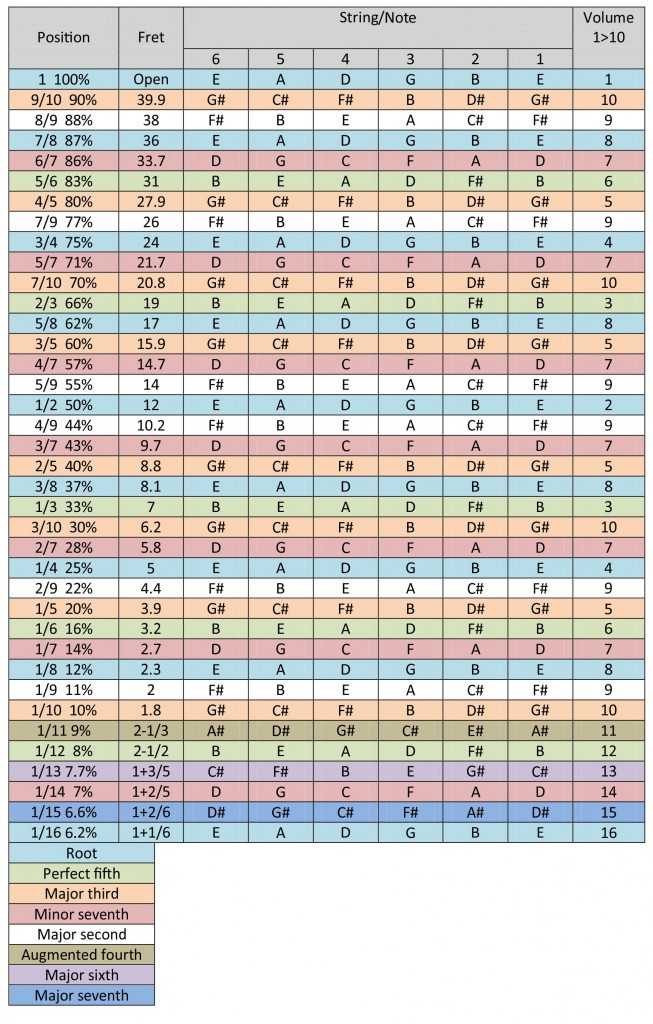
Above you can find the type of harmonic related to the position on the guitar.
Volume (level) of the harmonics: The first harmonic from the series (open string) is the one with the highest volume. The level decreases with every following harmonic. We can hear easily from a low pich note up to 5 harmonics (our human limit goes up to 16 harmonics). On a higher note the number of harmonics that we can hear decreases a lot due to our limitation in hearing really high pitch notes.
Observe the volume column in the table above. The open string is represented by the number 1 which means 100% of the volume. From there the value decreases, the 12th fret has the number 2 (50%), the 7th and 19th frets the number 3, and so on.
Higher volume (1) → lower volume (16):
Open string → Fret 12 → 7 and 19 → 5 and 24 → 3.9, 27.9, 8.8, 15.9 → 3.2, 31 → 2.7, 33.7, 5.8, 21.7, 9.7, 14.7 → etc…
Types of harmonics: There are essentially 4 types of harmonics on the guitar.
1 – Natural Harmonic: This is produced by touching the finger of the left hand lightly on the string. The positions with the greatest effect are those that are first in the harmonic series → frets 12, 7, 19, 5, 24, 3.9. (Image 1)
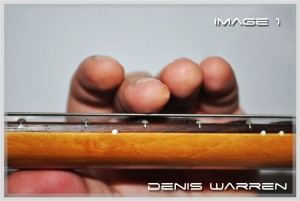
2 – Artificial/Pinch Harmonic: This is produced by plucking the string and touching it almost simultaneously with the nail or surface of the finger of your right hand (the one holding the plectrum – image 2). This way the quality of the vibration of the string changes, and the sounding of the fundamental note is avoided.
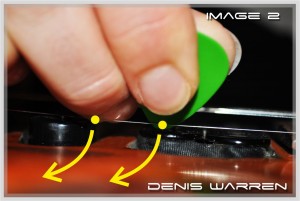
Another way is to pluck the string (image 3) and after touch the thumb of your plucking hand on the string (image 4).
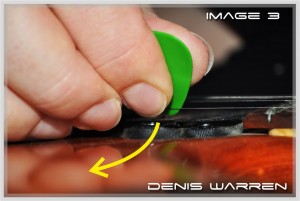
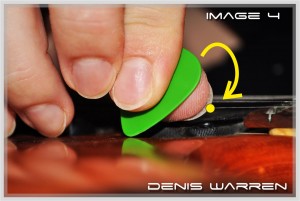
If you change the plucking position, this changes the harmonic. The most efficient positions are the ones that are multiples in distance, beginning 12 frets above the note.
Example: If you are pressing the 5th fret (1/4 of the length of the string), pluck in the positions 2/4 (12th fret) and ¾ (24th fret). Try also on the 3/8 (fret 8.1), 5/8 (fret 17), 7/8 (fret 36 – 87% of the length), 13/16 (fret 29 – 81%) and 15/16 (fret 48 – 93%).
3 – Tapping Harmonic: This is produced when you tap a finger of your plectrum hand 12 frets above the note that you are pressing with your other hand.
Example: If you are pressing the 5th fret, tap on the 5+12 = 17th fret.
Another technique that is very common on the classical guitar is to use the first and third fingers of your plectrum hand and to articulate in the same way as the natural harmonic is produced. Touch your first finger lightly on the string, 12 frets above your other hand, and pluck with your third finger. (Image 5)
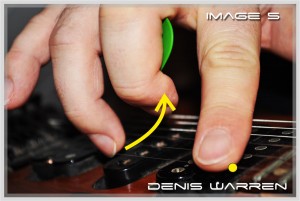
4 – Semi Harmonic: This is done just like the pinch harmonic but touching the finger of your plectrum hand in a very gentle way, so that the fundamental note can also be heard. It sounds like 2 notes are being played at the same time.
Audio samples from my cd DEEP:
1 – Beginning of the song Autumn Breeze with natural harmonics (clean guitar) in the whole extension of the introduction.
Audio clip: Adobe Flash Player (version 9 or above) is required to play this audio clip. Download the latest version here. You also need to have JavaScript enabled in your browser.
2 – Song: One Last Day, natural harmonics on the third string (frets 2, 3, 4 and 5). Note that the pitch of the notes decreases with the movement of the left hand towards the nut of the guitar, from the 5th to the 2nd fret, increasing the percentage of the string utilized (11% to 25%, or, 1/9 to ¼). Later on, a phrase ends with artificial harmonics.
Audio clip: Adobe Flash Player (version 9 or above) is required to play this audio clip. Download the latest version here. You also need to have JavaScript enabled in your browser.
3 – Song: When The Past Comes Back, where I play the chords of the harmony using tapping harmonics. In the example, the original version is played first, and after it is played without the melody.
Audio clip: Adobe Flash Player (version 9 or above) is required to play this audio clip. Download the latest version here. You also need to have JavaScript enabled in your browser.
4 – Slow solo from The Mental Storm, where many phrases are finalized with semi-harmonics. The last note of the solo is a natural harmonic controlled by the whammy bar.
Audio clip: Adobe Flash Player (version 9 or above) is required to play this audio clip. Download the latest version here. You also need to have JavaScript enabled in your browser.
Click here for the tabs of the songs used in the examples
Harmonics and Chords: When we play more than one harmonic at a time we can get different types of chords. Observe in the table below the harmonics from the Root (fundamental note) → Open string, 12th fret, 5th and 24th frets, frets 2.3, 8.1, 17, 36. When the first (E) and second (B) strings are played together we get the E5 powerchord. Playing the 1st, 2nd and 3rd (E B G) strings we get the Em triad, and including the 4th string (D) the Em7 seventh chord.
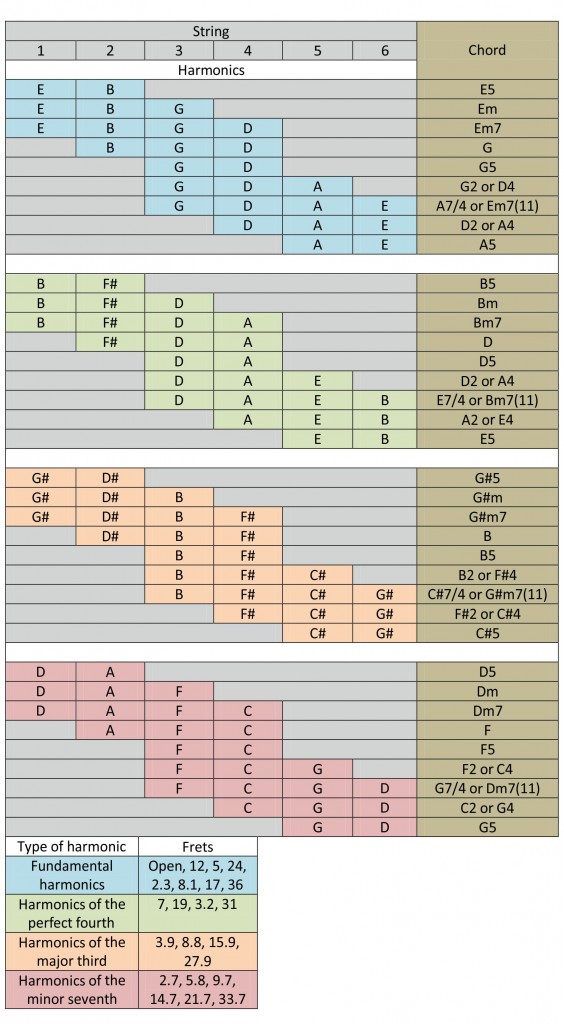
A beautiful way to use harmonics with chords is to divide the arrangement into 2 guitars, where the harmonics are added as a complement of the main chord of the harmony.
__________________________________________________________________________________
Example 1:
Chord: C (C E G)
Playing the fundamental harmonics of the 1st and 2nd strings (E B) → C (C E G) + notes E and B = C7M (Cmajor7)
Playing the fundamental harmonics of the 1st, 2nd and 3rd strings (E B G) → C (C E G) + notes E, B and G = C7M (Cmajor7)
Audio clip: Adobe Flash Player (version 9 or above) is required to play this audio clip. Download the latest version here. You also need to have JavaScript enabled in your browser.
Playing the fundamental harmonics of the 1st, 2nd, 3rd and 4th strings (E B G D) → C (C E G) + notes E, B, G and D = C7M(9) (Cmajor7(9))
Audio clip: Adobe Flash Player (version 9 or above) is required to play this audio clip. Download the latest version here. You also need to have JavaScript enabled in your browser.
__________________________________________________________________________________
Example 2:
Chord: F (F A C)
Playing the fundamental harmonics of the 1st and 2nd strings (E B) → F (F A C) + notes E and B = F7M(#11)
Audio clip: Adobe Flash Player (version 9 or above) is required to play this audio clip. Download the latest version here. You also need to have JavaScript enabled in your browser.
Playing the fundamental harmonics of the 1st, 2nd and 3rd strings (E B G) → F (F A C) + notes E, B and G = F7M(9/#11)
Audio clip: Adobe Flash Player (version 9 or above) is required to play this audio clip. Download the latest version here. You also need to have JavaScript enabled in your browser.
__________________________________________________________________________________
Example 3:
Powerchord: C5 (C G)
Playing the fundamental harmonics of the 1st and 2nd strings (E B) → C5 (C G) + notes E and B = C7M (Cmajor7)
Playing the fundamental harmonics of the 1st, 2nd and 3rd strings (E B G) → C5 (C G) + notes E, B and G = C7M (Cmajor7)
Audio clip: Adobe Flash Player (version 9 or above) is required to play this audio clip. Download the latest version here. You also need to have JavaScript enabled in your browser.
Playing the fundamental harmonics of the 1st, 2nd, 3rd and 4th strings (E B G D) → C5 (C G) + notes E, B, G and D = C7M(9) (Cmajor7(9))
Audio clip: Adobe Flash Player (version 9 or above) is required to play this audio clip. Download the latest version here. You also need to have JavaScript enabled in your browser.
__________________________________________________________________________________
Harmonics and Tone: The tone makes a huge difference to the quality and strength of the harmonics on the guitar. Treble equalizations tend to bring more harmonics to the sound and a higher distortion creates body. As the tone is directly related to the quality of the equipment, better equipment delivers better harmonics.
Low quality guitar cables usually compress the sound, cutting the higher frequences and causing the higher harmonics of the series to disappear. Active pickups on the other hand bring body and a fat high end, creating more harmonics.
Valve amplifiers increase the volume of the even harmonics (mainly the fundamental ones), bringing a cleaner and well defined distortion.
Harmonics and Acoustics: A well-balanced music room or venue has a good acoustic size proportion that avoids excessive reflections, flutter echo, and stationary waves, among other things. But most of the time we are obliged to play in unideal places, and it is really important to be able to adapt to the conditions. This is vital for a good performance.
The higher harmonics (thirds, sevenths and seconds) are the most sensitive of the series, so test the acoustics by playing these types of harmonics and move your amplifier around (left and right, front and back, up and down) trying to achieve a sweet spot.
Feedback: When we sustain a note, trying to get feedback from the amplifier, we are actually evidencing individual harmonics from the series. Changing the position of the guitar makes the harmonics change. So it is very important before rehearsing or playing live that you check where on the stage each harmonic is strengthened. Try to find at least the fundamental, third and fifth harmonics.















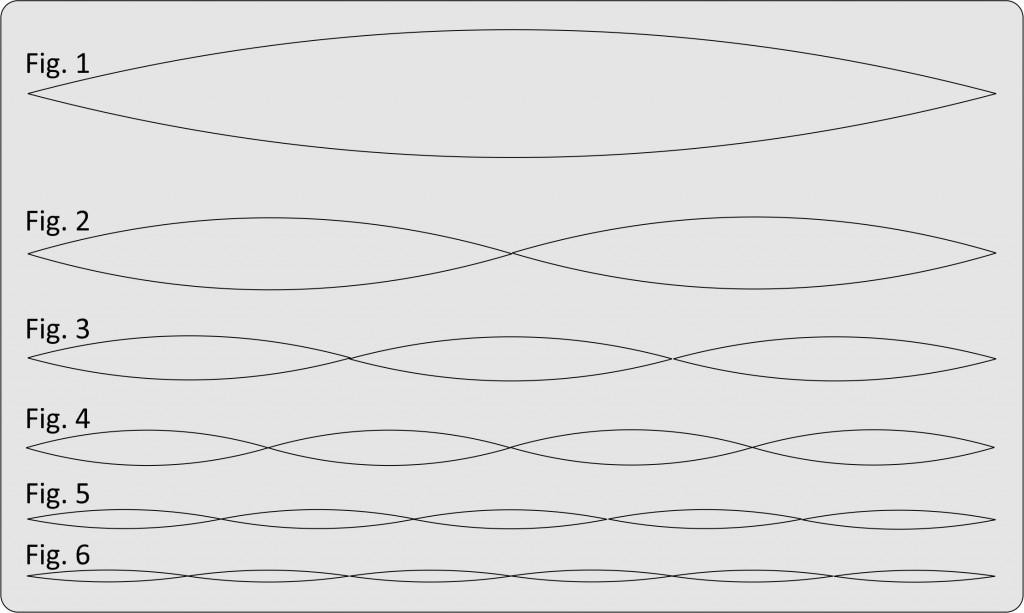
















Sites
Support